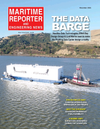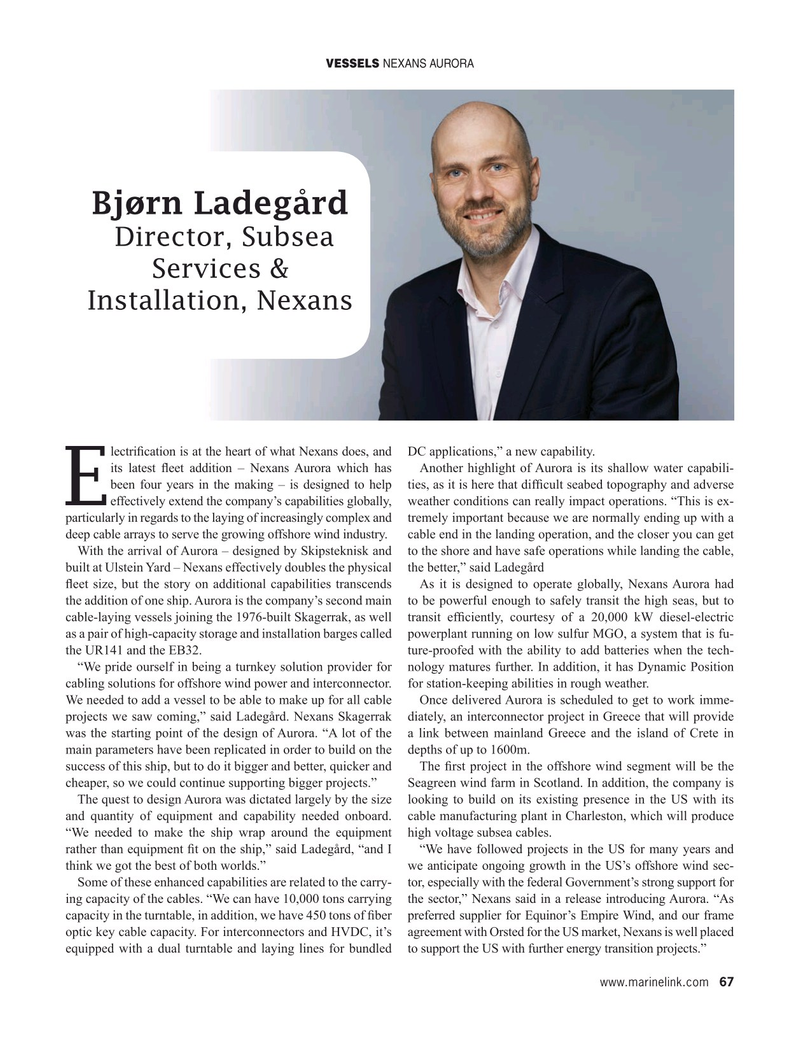
Page 67: of Maritime Reporter Magazine (November 2021)
The Workboat Edition
Read this page in Pdf, Flash or Html5 edition of November 2021 Maritime Reporter Magazine
VESSELS NEXANS AURORA
Bjørn Ladegård Director, Subsea
Services &
Installation, Nexans lectri? cation is at the heart of what Nexans does, and DC applications,” a new capability.
its latest ? eet addition – Nexans Aurora which has Another highlight of Aurora is its shallow water capabili- been four years in the making – is designed to help ties, as it is here that dif? cult seabed topography and adverse
E effectively extend the company’s capabilities globally, weather conditions can really impact operations. “This is ex- particularly in regards to the laying of increasingly complex and tremely important because we are normally ending up with a deep cable arrays to serve the growing offshore wind industry. cable end in the landing operation, and the closer you can get
With the arrival of Aurora – designed by Skipsteknisk and to the shore and have safe operations while landing the cable, built at Ulstein Yard – Nexans effectively doubles the physical the better,” said Ladegård ? eet size, but the story on additional capabilities transcends As it is designed to operate globally, Nexans Aurora had the addition of one ship. Aurora is the company’s second main to be powerful enough to safely transit the high seas, but to cable-laying vessels joining the 1976-built Skagerrak, as well transit ef? ciently, courtesy of a 20,000 kW diesel-electric as a pair of high-capacity storage and installation barges called powerplant running on low sulfur MGO, a system that is fu- the UR141 and the EB32. ture-proofed with the ability to add batteries when the tech- “We pride ourself in being a turnkey solution provider for nology matures further. In addition, it has Dynamic Position cabling solutions for offshore wind power and interconnector. for station-keeping abilities in rough weather.
We needed to add a vessel to be able to make up for all cable Once delivered Aurora is scheduled to get to work imme- projects we saw coming,” said Ladegård. Nexans Skagerrak diately, an interconnector project in Greece that will provide was the starting point of the design of Aurora. “A lot of the a link between mainland Greece and the island of Crete in main parameters have been replicated in order to build on the depths of up to 1600m.
success of this ship, but to do it bigger and better, quicker and The ? rst project in the offshore wind segment will be the cheaper, so we could continue supporting bigger projects.” Seagreen wind farm in Scotland. In addition, the company is
The quest to design Aurora was dictated largely by the size looking to build on its existing presence in the US with its and quantity of equipment and capability needed onboard. cable manufacturing plant in Charleston, which will produce “We needed to make the ship wrap around the equipment high voltage subsea cables.
rather than equipment ? t on the ship,” said Ladegård, “and I “We have followed projects in the US for many years and think we got the best of both worlds.” we anticipate ongoing growth in the US’s offshore wind sec-
Some of these enhanced capabilities are related to the carry- tor, especially with the federal Government’s strong support for ing capacity of the cables. “We can have 10,000 tons carrying the sector,” Nexans said in a release introducing Aurora. “As capacity in the turntable, in addition, we have 450 tons of ? ber preferred supplier for Equinor’s Empire Wind, and our frame optic key cable capacity. For interconnectors and HVDC, it’s agreement with Orsted for the US market, Nexans is well placed equipped with a dual turntable and laying lines for bundled to support the US with further energy transition projects.” www.marinelink.com 67
MR #11 (66-74).indd 67 11/4/2021 11:25:05 AM

 66
66

 68
68
